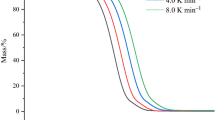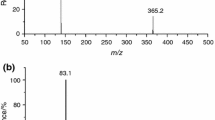Abstract
As a new solvent with a broad prospect, ionic liquids (ILs) are widely used in catalysis, organic synthesis, and electrochemistry due to their peculiar physical and chemical properties. Nonetheless, their safety issues are often overlooked. This paper aims to decode the thermal reaction and decomposition hazard characteristics of ILs with an innovative method. Initially, the results of the thermal stability study of 1-n-butyl-3-methylimidazolium dicyanamide ([BMIM]DCN) using non-isothermal thermogravimetric and adiabatic analysis show that the decomposition process of [BMIM]DCN can be divided into three stages. By employing the Flynn–Wall–Ozawa and Kissinger–Akahira–Sunose methods, the apparent activation energy of decomposition was calculated and the stability of [BMIM]DCN was compared with structure-similar ILs (with the same imidazole cation). To predict the mechanism of [BMIM]DCN decomposition in the early stage, the products of the [BMIM]DCN under temperature-programmed conditions were analyzed by TG-FTIR, and a huge amount of toxic gases were detected in its decomposition products. In adiabatic tests, there is a sharp increase in pressure at about 382 °C, and the pressure of the system increases by about 12 times within 0.2 s. Furthermore, product analysis results show that the danger of the thermal decomposition of [BMIM]DCN is mainly due to the rapid pressure rise and toxicity caused by the massive gas products, such as HCN and NH3. The findings of this study can be used to develop thermal stability prediction models for similar ILs and provide the necessary foundation for the design and selection of precise processing methods and appropriate safety systems.












Similar content being viewed by others
Abbreviations
- α :
-
Conversion degree (%)
- β :
-
Heating rate (°C min–1)
- A :
-
Pre-exponential factor (min–1)
- E a :
-
Apparent activation energy (kJ mol–1)
- g(α):
-
Integral form of mechanism function
- k :
-
Rate constant (mol1–n Ln–1 s–1, n is reaction order)
- M :
-
Molecular weight (g mol–1)
- n :
-
Reaction order
- P max :
-
Maximum pressure (bar)
- R :
-
Universal gas constant (J mol–1 K–1)
- R 2 :
-
Correlation coefficient (dimensionless)
- T :
-
Temperature of sample (K)
- T 0 :
-
Onset temperature (°C)
- T p :
-
Peak temperature (K
References
Marciniak A. Influence of cation and anion structure of the ionic liquid on extraction processes based on activity coefficients at infinite dilution. A review. Fluid Phase Equilib. 2010;294(1–2):213–33.
Kubisa P. Ionic liquids as solvents for polymerization processes—progress and challenges. Prog Polym Sci. 2009;34(12):1333–47.
Awad WH, Gilman JW, Nyden M, Harris RH, Sutto TE, Callahan J, et al. Thermal degradation studies of alkyl-imidazolium salts and their application in nanocomposites. Thermochim Acta. 2004;409(1):3–11.
Olivier-Bourbigou H, Magna L, Morvan D. Ionic liquids and catalysis: recent progress from knowledge to applications. Appl Catal A Gen. 2010;373(1–2):1–56.
Seki S, Ohno Y, Kobayashi Y, Miyashiro H, Usami A, Mita Y, et al. Imidazolium-based room-temperature ionic liquid for lithium secondary batteries. J Electrochem Soc. 2007;154(3):A173.
Bonĥte P, Dias AP, Papageorgiou N, Kalyanasundaram K, Grätzel M. Hydrophobic, highly conductive ambient-temperature molten salts. Inorg Chem. 1996;35(5):1168–78.
McEwen AB, Ngo HL, LeCompte K, Goldman JL. Electrochemical properties of imidazolium salt electrolytes for electrochemical capacitor applications. J Electrochem Soc. 1999;146(5):1687–95.
Ngo HL, LeCompte K, Hargens L, McEwen AB. Thermal properties of imidazolium ionic liquids. Thermochim Acta. 2000;357–358:97–102.
Holbrey JD, Seddon KR. The phase behaviour of 1-alkyl-3-methylimidazolium tetrafluoroborates; ionic liquids and ionic liquid crystals. J Chem Soc Dalt Trans. 1999;13:2133–9.
Liaw HJ, Liou YR, Liu PH, Chen HY, Shu CM. Increased flammability hazard when ionic liquid [C6mim][Cl] is exposed to high temperatures. J Hazard Mater. 2019;367:407–17.
Chen CC, Liaw HJ, Chen YN. Flammability characteristics of ionic liquid 1-decyl-3-methylimidazolium bis(trifluoromethylsulfonyl)imide. J Loss Prev Process Ind. 2017;49:620–9.
Liaw HJ, Chen CC, Chen YC, Chen JR, Huang SK, Liu SN. Relationship between flash point of ionic liquids and their thermal decomposition. Green Chem. 2012;14(7):2001–8.
Liu SH, Lin WC, Xia H, Hou HY, Shu CM. Combustion of 1-butylimidazolium nitrate via DSC, TG, VSP2, FTIR, and GC/MS: an approach for thermal hazard, property and prediction assessment. Process Saf Environ Prot. 2018;116:603–14.
Ding J, Chen L, Xu Q, Yang S, Jiang J, Ye S. Differential isoconversional kinetic approach for accelerating rate calorimetry. Thermochim Acta. 2020;689:178607.
Fredlake CP, Crosthwaite JM, Hert DG, Aki SNVK, Brennecke JF. Thermophysical properties of imidazolium-based ionic liquids. J Chem Eng Data. 2004;49(4):954–64.
Cao Y, Mu T. Comprehensive investigation on the thermal stability of 66 ionic liquids by thermogravimetric analysis. Ind Eng Chem Res. 2014;53(20):8651–64.
Ozawa T. A new method of analyzing thermogravimetric data. Bull Chem Soc Jpn. 1965;38(11):1881–6.
Flynn JH, Wall LA. A quick, direct method for the determination of activation energy from thermogravimetric data. J Polym Sci B Polym Lett. 1966;4(5):323–8.
Doyle CD. Series approximations to the equation of thermogravimetric data. Nature. 1965;207(4994):290–1.
Coats AW, Redfern JP. Kinetic parameters from thermogravimetric data. Nature. 1964;201:68–9.
Liu SH, Zhang XZ, Zhang B, Su H, Laiwang B. Thermal decomposition characteristics and potential hazards of three new ionic liquids of alkyl imidazoline hexafluorophosphates by TG and ARC. J Therm Anal Calorim. 2020. https://doi.org/10.1007/s10973-020-10356-z.
Acknowledgements
The authors would like to express their appreciation to the Anhui Provincial Natural Science Foundation, China, for its financial support of this study under the contract number 1908085ME125.
Author information
Authors and Affiliations
Contributions
W-T Wang was involved in the conceptualization, data curation, formal analysis, investigation, methodology—lead, software—equal, writing—original draft—equal, and writing—review and editing—lead. S-H Lin contributed to the funding acquisition, methodology, project administration, resources, supervision, and writing—review and editing—equal. Y-F Cheng contributed to the investigation—supporting, supervision—equal, methodology—equal, validation—supporting, writing—review and editing—supporting. Y Wang was involved in the methodology, software, and writing—review and editing—equal. C-F Yu was involved in the investigation, methodology, and resources—equal.
Corresponding author
Additional information
Publisher's Note
Springer Nature remains neutral with regard to jurisdictional claims in published maps and institutional affiliations.
Rights and permissions
About this article
Cite this article
Wang, WT., Liu, SH., Cheng, YF. et al. Evaluation of thermal decomposition characteristics and potential hazards of 1-n-butyl-3-methylimidazolium dicyanamide by STA, ARC, and TG-FTIR. J Therm Anal Calorim 147, 11127–11137 (2022). https://doi.org/10.1007/s10973-022-11333-4
Received:
Accepted:
Published:
Issue Date:
DOI: https://doi.org/10.1007/s10973-022-11333-4




